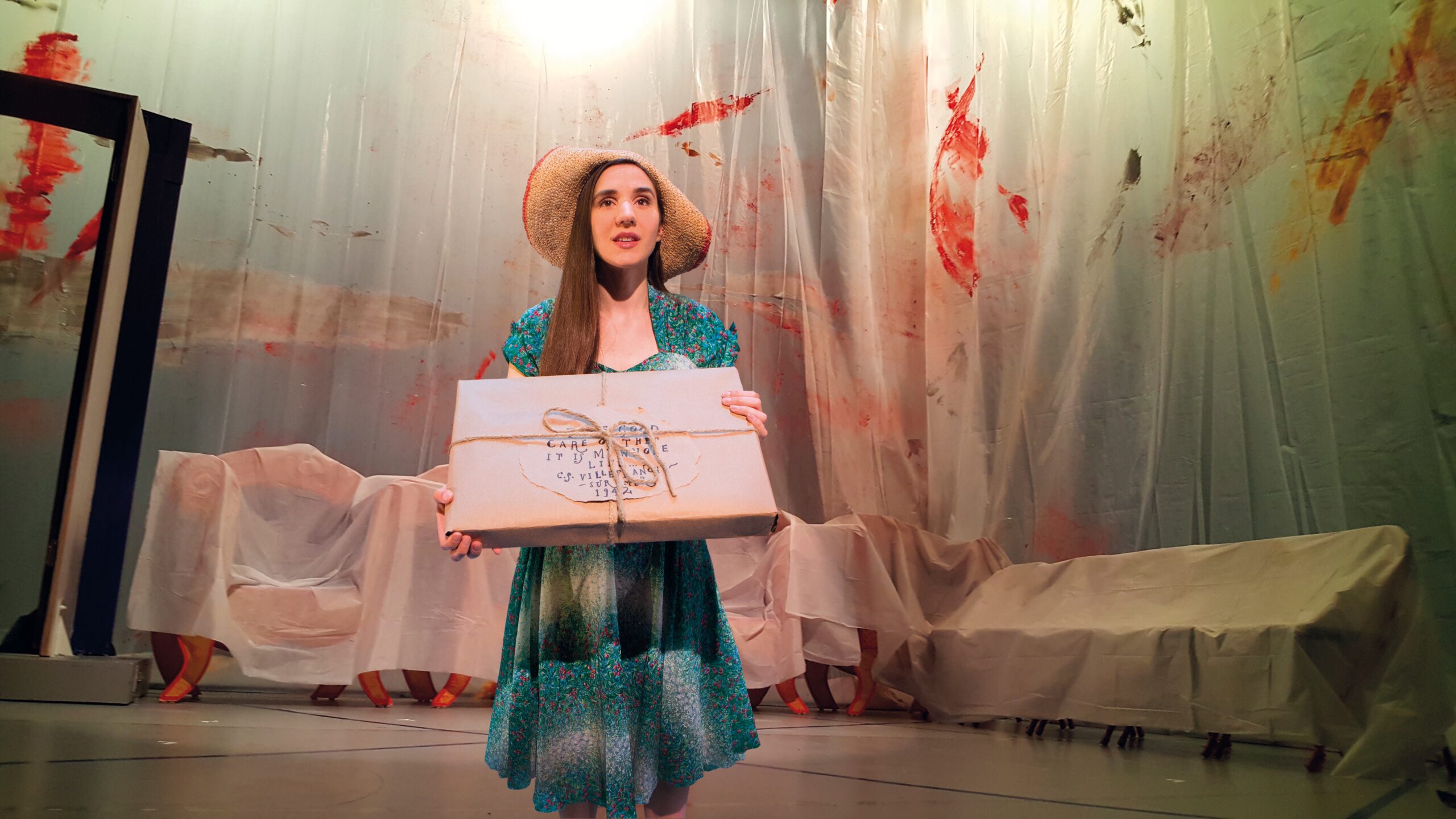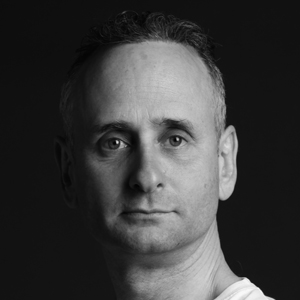My 20-year journey with Charlotte
It started with an obsession, an idea I could not shake, a meeting with someone whose life seemed to hang in the balance, and for whom I might be a champion.
It is hard to express the depth of my fascination with Charlotte Salomon. Nearly 20 years after I first encountered her paintings at the Art Gallery of Ontario (AGO), I am still working on a chamber musical inspired by her life and artwork.

Cast of 2017 production of Charlotte. Photo credit: Cylla von Tiedemann.
Back in 2000 I spent two full days immersed in her nearly 800 paintings, stunned by their intricate beauty, overwhelmed by their narrative heft. I listened to the music she proposed as accompaniment and read every word of the text she offered for what constitutes, as others have pointed out, a thick graphic novel and a thinly veiled autobiography.
As she sensed the walls of history closing in on her, she wrapped the paintings in brown paper and handed them to a friend…
Salomon was born in Berlin in 1917. As a young Jewish teen, she witnessed the rise of Nazism. Between 1940 and 1942 she spent most of her time painting feverishly, holed up in a pension near Villefranche in the South of France. As she sensed the walls of history closing in on her, she wrapped the paintings in brown paper and handed them to a friend with the words: “Take good care of this… it is my whole life.” A few months later Charlotte, age 26 and pregnant, was killed in Auschwitz.
Examining each image, I fell in love with this highly intelligent and talented young artist, whose ironic take on events I thought I knew well was completely disarming. Here was a playful, insightful, and articulate witness, not only to the rise of Nazism but to a complex slew of artistic, familial, and societal transformations.

Credit: Collection Jewish Historical Museum, Amsterdam © Charlotte Salomon Foundation Charlotte Salomon ®
What gripped me from the start was the title of her magnum opus: Life? Or Theatre?, a question I often ask myself. How does the theatre I do affect my life and vice versa? I considered how Charlotte negotiated the borderline between what she understood to be life and theatre.
Then there was her subtitle, ein singspiel, literally “a song play.” Salomon understood her life as a performance, a particular brand of music theatre. Singspiels are what Brecht and Weill wrote; Mozart’s operas with spoken dialogue are also considered singspiels. Charlotte, through a visual art medium, imagined a living piece of art, one with curtains parting and a cast of characters inhabiting a play with music.

Credit: Collection Jewish Historical Museum, Amsterdam
© Charlotte Salomon Foundation Charlotte Salomon ®
As I traversed the gallery Charlotte’s paintings seemed to be calling to me, reaching through time to grab my sleeve and insist that her voice be heard. I vowed to realize the singspiel Salomon envisioned.
Over the past 19 years, I often returned to Charlotte’s artwork. I followed it to Paris and into the vaults of the Jewish Historical Museum in Amsterdam. I visited the residence where she painted in the South of France. I read everything I could get my hands on, met with Salomon scholars and students of Alfred Wolfsohn, a vocal teacher and her lover.

Alon Nashman and Adanya Dunn in 2017 production of Charlotte. Photo credit: Cylla von Tiedemann.
Wolfsohn was an extravagant character, a self-styled “Prophet of Song” who had some unusual and persuasive notions about the range of the human voice. His approach was informed by the tortured sounds he heard as a soldier in the trenches of World War I. He believed that everyone was capable of a five-octave range; his most accomplished students could sing all the roles in Mozart’s Magic Flute. Wolfsohn’s “extended voice” technique was disseminated, and is taught today by local vocal artists Fides Krucker and Stacie Dunlop.
Charlotte’s slightly ridiculous version of Wolfsohn, to whom she gave the name Amadeus Daberlohn, was the role I planned to write for myself. A production began to crystalize in my mind’s eye with me in the roles of writer and performer. I now needed a director.
Enter Pamela Howard, a British director and scenographer who actually draws theatre in a manner similar to Charlotte and who was familiar with Salomon’s artwork.

Pamela Howard in her Studio in Selsey, U.K. Photo from TheStage.co.uk
Over conversations in 2013, we discovered that we shared a vision for how to adapt Salomon’s work: We would not project the paintings, flattening her textured images with technology and perhaps overwhelming the live performers. Instead we would use them as inspiration, a storyboard for a mutable art installation in which the paintings would come to life on stage.
I began collapsing the massive collection of images and words into 18 essential episodes, whittling Charlotte’s text to create songs and scenes. Fourteen years after I first met Charlotte, a workshop took place at Canadian Stage in the summer of 2014.
Pamela introduced me to Czech composer Aleš Brezina, a master of many musical styles with a devious sense of humour. The three of us had to consider carefully every expansion into the extravagance of singing. Some music in our singspiel grew out of Charlotte’s musical references. Some of the songs received gorgeous melody while others are essentially sound poems. Aleš laid out his wish list for a band: keyboards, trumpet, bass clarinet, and cello. And so it is scored.

Alon Nasman, Pamela Howard, and Aleš Brezina. Photo provided by Alon Nashman.
As I continued to shape the written material, I tried to remain true to Charlotte’s voice and her sense of humour. Charlotte could dispense wicked wit and biting satire. She was willing to ridicule excess, vanity, and hypocrisy in everyone, from her operatic contralto stepmother, to her voice-teacher lover, to the Nazi minister of propaganda. Her mockery even extended to the symbol of Nazi pride, the swastika, which she always painted backwards. Following her lead, I created scenes that have elements of absurd cabaret, bitterly comic in a tone similar to the political theatre Salomon would have seen during that era in Berlin.
People who knew Charlotte remember her as a painfully shy young woman who spent most of her time silently sketching and observing from the corners. Even in her paintings she rarely places herself in the frame. There has been a constant challenge in making an introvert our central character. Sometimes it felt like we were pulling Charlotte in from the margins, giving her voice when she might have preferred silence. But, when I recalled my first impression of her art, I knew she had to be central to her own story.

Adanya Dunn, Derek Kwan, and Ariana Chris from the 2017 production of Charlotte. Photo credit: Cylla von Tiedemann.
I must admit that we are not alone in developing a project with Charlotte Salomon at the core. I know at least six other artists, in Canada alone, who have worked on an adaptation of her artwork. There is currently a Canadian-French co-produced animation film in post-production, which features the voices of many local actors. There was a ballet in Germany, an opera in Austria, and a bestselling novel in France. Salomon’s artwork was re-printed by two different publishers in the past year. I feel that these various expressions of Salomon’s art are working in symbiosis, if independently, united by a desire to see this woman receive a portion of the recognition, and in a sense the life, she was robbed of in Auschwitz.

Credit: Collection Jewish Historical Museum, Amsterdam © Charlotte Salomon Foundation Charlotte Salomon ®
Salomon’s art was a death-defying example of creativity in resistance to tyranny.
In the final images of Life? Or Theatre?, after the wartime suicide of Charlotte’s grandmother, there are a series of paintings showing her grandfather making a desperate attempt to have sex with Charlotte. Four years ago, pages of a letter, hand-scrawled by Salomon in multi-coloured block letters, was released after years of being repressed by the family. In the letter, Charlotte admits to poisoning her grandfather and causing his death. This confession, addressed to Daberlohn (not her real lover but the fictionalized version of him), sent a shock through the community of those who study, adapt, and adore Salomon. How do we reconcile the sensitive lonely only child with someone capable of poisoning her grandfather? Our answer to that question is embedded in the libretto.

Marie-Josée Chartier, Shaina Silver-Baird, Andrew Cohen, Pamela Howard in rehearsal for 2019 production. Photo credit: Jenna Warriner.
In June 2017 we unveiled Charlotte: A Tri-Coloured Play with Music at Luminato Festival, and at World Stage Design Festival in Taipei City. It was truly a work-in-progress, and it was also a culmination of my work with Aleš, Pamela, and with an extensive and amazing creative team. I had functioned as initiator, producer, librettist, and performer. The demands of the process hollowed me out, but the outcome lifted me to a new awareness of the power of art. As we performed, then interacted with audience members in our Living Museum of production artifacts, I was overwhelmed by a triumphant sense of purpose fulfilled, and a deeper sense of the toll of war and genocide. I grieved anew for Charlotte Salomon, and considered the fate of brilliant young unknown artists in Aleppo or among the Rohingya today.

2017 cast of Charlotte. Photo credit: Cylla von Tiedemann.
This year we are taking the piece to Israel, Ukraine, and Czech Republic. I have outgrown the role I wrote for myself, but I am thrilled to see what unfolds from the other side of the table.

Shaina Silver-Baird as Charlotte in rehearsal for 2019 production of Charlotte. Photo credit: Jenna Warriner.
Salomon’s art was a death-defying example of creativity in resistance to tyranny. We sought to make a living, breathing expression of her Life? Or Theatre?, a complete synchronicity of image, music, and word, in the format she called forth: ein singspiel. It has taken a while to get here, but my passion for Charlotte Salomon has not diminished, and I doubt it ever will.









Comments